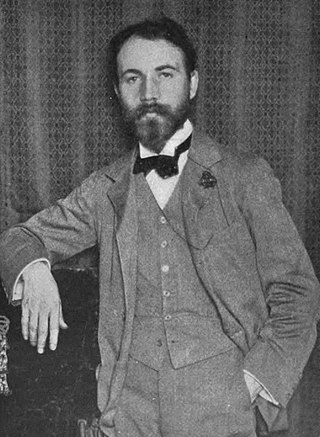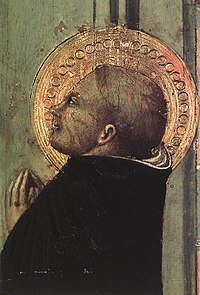
The Sienese School of painting flourished in Siena, Italy, between the 13th and 15th centuries. Its most important artists include Duccio, whose work shows Byzantine influence, his pupil Simone Martini, the brothers Pietro and Ambrogio Lorenzetti and Domenico and Taddeo di Bartolo, Sassetta, and Matteo di Giovanni.

Piero della Francesca was an Italian painter of the Early Renaissance. To contemporaries he was also known as a mathematician and geometer. Nowadays Piero della Francesca is chiefly appreciated for his art. His painting is characterized by its serene humanism, its use of geometric forms and perspective. His most famous work is the cycle of frescoes The History of the True Cross in the church of San Francesco in the Tuscan town of Arezzo.

Domenico Veneziano was an Italian painter of the early Renaissance, active mostly in Perugia and Tuscany.

Luca Signorelli was an Italian Renaissance painter from Cortona, in Tuscany, who was noted in particular for his ability as a draftsman and his use of foreshortening. His massive frescos of the Last Judgment (1499–1503) in Orvieto Cathedral are considered his masterpiece.

Lorenzo Lotto was an Italian Renaissance painter, draughtsman, and illustrator, traditionally placed in the Venetian school, though much of his career was spent in other north Italian cities. He painted mainly altarpieces, religious subjects and portraits. He was active during the High Renaissance and the first half of the Mannerist period, but his work maintained a generally similar High Renaissance style throughout his career, although his nervous and eccentric posings and distortions represented a transitional stage to the Florentine and Roman Mannerists.

Bernard Berenson was an American art historian specializing in the Renaissance. His book The Drawings of the Florentine Painters was an international success. His wife Mary is thought to have had a large hand in some of the writings.

Domenico di Pace Beccafumi was an Italian Renaissance-Mannerist painter active predominantly in Siena. He is considered one of the last undiluted representatives of the Sienese school of painting.

Giovanni di Paolo di Grazia was an Italian painter, working primarily in Siena, becoming a prolific painter and illustrator of manuscripts, including Dante's texts. He was one of the most important painters of the 15th century Sienese School. His early works show the influence of earlier Sienese masters, but his later style was more individual, characterized by cold, harsh colours and elongated forms. His style also took on the influence of International Gothic artists such as Gentile da Fabriano. Many of his works have an unusual dreamlike atmosphere, such as the surrealistic Miracle of St. Nicholas of Tolentino painted about 1455 and now housed in the Philadelphia Museum of Art, while his last works, particularly Last Judgment, Heaven, and Hell from about 1465 and Assumption painted in 1475, both at Pinacoteca Nazionale (Siena), are grotesque treatments of their lofty subjects. Giovanni's reputation declined after his death but was revived in the 20th century.
Sano di Pietro or Ansano di Pietro di Mencio (1405–1481) was an Italian painter of the Sienese school of painting. He was active for about half a century during the Quattrocento period, and his contemporaries included Giovanni di Paolo and Sassetta.

Matteo di Giovanni was an Italian Renaissance artist from the Sienese School.
The decade of the 1430s in art involved some significant events.

The Master of the Osservanza Triptych, also known as the Osservanza Master and as the Master of Osservanza, is the name given to an Italian painter of the Sienese School active about 1430 to 1450.

Bernardino Fungai was an Italian painter whose work marks the transition from late Gothic painting to the early Renaissance in the Sienese school. He maintained a fairly archaic style in his works, which are mainly of a devotional nature.

Villa I Tatti, The Harvard Center for Italian Renaissance Studies is a center for advanced research in the humanities located in Florence, Italy, and belongs to Harvard University. It houses a collection of Italian primitives, and of Chinese and Islamic art, as well as a research library of 140,000 volumes and a collection of 250,000 photographs. It is the site of Italian and English gardens. Villa I Tatti is located on an estate of olive groves, vineyards, and gardens on the border of Florence, Fiesole and Settignano.

A Madonna of humility or Virgin of humility is a depiction in art of the Virgin Mary sitting on the ground, or upon a low cushion. She usually holds the Christ Child in her lap, making it one form of the Madonna and Child. The iconography originated in the 14th century, and was most common in that and the following century.

The Pinacoteca Nazionale is a national museum in Siena, Tuscany, Italy. Inaugurated in 1932, it houses especially late medieval and Renaissance paintings from Italian artists. It is housed in the Brigidi and Buonsignori palaces in the city's center: the former, built in the 14th century, it is traditionally identified as the Pannocchieschi family's residence. The Palazzo Bichi-Buonsignori, built in the 15th century, was until recently thought to have a 19th-century neo-medieval façade based on the city's Palazzo Pubblico; however, restoration in 2022 revealed that it is mostly original.

Andrea di Niccolò, also Andrea di Niccolò di Giacomo, (1440–1514) was an Italian painter of the Sienese School.

San Francesco is a Gothic-style, Roman Catholic church and Monastery located in the Piazza of the same name in Sansepolcro, province of Arezzo, region of Tuscany, Italy.
Enzo Carli was an Italian art historian and art critic.
Dillian Rosalind Gordon OBE is a British art historian who worked as a curator at the National Gallery, London from 1978 to 2010, latterly as Curator of Italian Paintings before 1460. She lives in Oxford. She was appointed OBE in 2011 for services to Early Italian Painting. She has authored and co-authored many books, including several National Gallery catalogues.






















